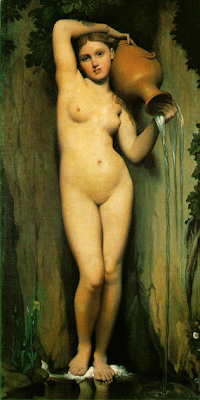I'm not a huge fan of any of the art we just reviewed (except Caravaggio for his use of light and interesting viewpoints). It feels too static and staid compared to modern art (to me).
But we will see that a lot of modern artists based their compositions on the classical composition of earlier artists. However, they often hid it subtly under brighter colors, more splashy brushwork, and/or more contemporary themes.
A very strong example of the use of underlying composition is the art of Edgar Degas (1834–1917 - Impressionism). Although a master of 3D modeling, his work also always eventually becomes a strong 2D composition. Degas had both strong subjective interest (subject matter, emotion, story-telling), and strong abstract interest.
One example of this is Degas' "Woman in the Bath" of 1886. Without the hoop, this would have been a flat picture.

Degas used none of the Renaissance rules of foreshortening i.e. the woman's back is not in classical perspective, not does it use the play of angles to curves.
And Degas' composition is not the clumping of figures used in the Renaissance, nor the running rhythm of Mannerism, nor the spiral of the Baroque. Picture after picture, Degas made strong use of diagonals, circles, and planes to add dynamism to a scene.
Also notice how his repetition of and within forms builds on the eye's natural movement to parallels on repeated forms.


Even when one doesn't notice it because it fits the theme, Degas cultivated his two-dimensional composition. For example, in this picture, the figure's legs, which would not have fit well with the 2D scheme Degas was developing (a sideways V), are putout of the way with the placement of a table. Or one can use an area of shadow for a similar purpose.

































